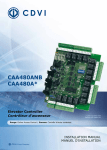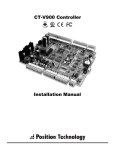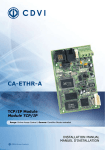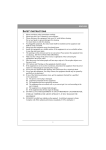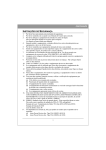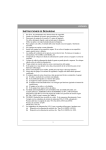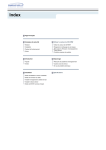Download CA-A480-A : Reference & Installation Manual
Transcript
CA-A480-A Elevator Controller Reference & Installation Manual TABLE OF CONTENTS INTRODUCTION . . . . . . . . . . . . . . . . . . . . . . . . . . . . . . . . . . . . . . . . . . . . . . . . . . . . . . . . . . . . . . . . . . 4 Introduction . . . . . . . . . . . . . . . . . . . . . . . . . . . . . . . . . . . . . . . . . . . . . . . . . . . . . . . . . . . . . . . . . . . . . . . . . . . . . . . . . . . . . . . . . . . . . 4 Specifications . . . . . . . . . . . . . . . . . . . . . . . . . . . . . . . . . . . . . . . . . . . . . . . . . . . . . . . . . . . . . . . . . . . . . . . . . . . . . . . . . . . . . . . . . . . 4 LOCATION AND INSTALLATION. . . . . . . . . . . . . . . . . . . . . . . . . . . . . . . . . . . . . . . . . . . . . . . . . . . . . . 5 Location and Mounting . . . . . . . . . . . . . . . . . . . . . . . . . . . . . . . . . . . . . . . . . . . . . . . . . . . . . . . . . . . . . . . . . . . . . . . . . . . . . . . . . . . . Connecting the E-Bus . . . . . . . . . . . . . . . . . . . . . . . . . . . . . . . . . . . . . . . . . . . . . . . . . . . . . . . . . . . . . . . . . . . . . . . . . . . . . . . . . . . . . Installing a Controller Box Tamper Switch . . . . . . . . . . . . . . . . . . . . . . . . . . . . . . . . . . . . . . . . . . . . . . . . . . . . . . . . . . . . . . . . . . . . . Connecting AC Power . . . . . . . . . . . . . . . . . . . . . . . . . . . . . . . . . . . . . . . . . . . . . . . . . . . . . . . . . . . . . . . . . . . . . . . . . . . . . . . . . . . . Connecting the Backup Battery . . . . . . . . . . . . . . . . . . . . . . . . . . . . . . . . . . . . . . . . . . . . . . . . . . . . . . . . . . . . . . . . . . . . . . . . . . . . . 5 5 6 6 7 FLOOR CONTROL CONNECTIONS . . . . . . . . . . . . . . . . . . . . . . . . . . . . . . . . . . . . . . . . . . . . . . . . . . . . 8 Standard Button Control Connection . . . . . . . . . . . . . . . . . . . . . . . . . . . . . . . . . . . . . . . . . . . . . . . . . . . . . . . . . . . . . . . . . . . . . . . . . 8 Fail-Safe . . . . . . . . . . . . . . . . . . . . . . . . . . . . . . . . . . . . . . . . . . . . . . . . . . . . . . . . . . . . . . . . . . . . . . . . . . . . . . . . . . . . . . . . . . . 8 Fail-Secure . . . . . . . . . . . . . . . . . . . . . . . . . . . . . . . . . . . . . . . . . . . . . . . . . . . . . . . . . . . . . . . . . . . . . . . . . . . . . . . . . . . . . . . . . 9 Floor Security Input Control . . . . . . . . . . . . . . . . . . . . . . . . . . . . . . . . . . . . . . . . . . . . . . . . . . . . . . . . . . . . . . . . . . . . . . . . . . . . . . . 10 JUMPER SETTINGS . . . . . . . . . . . . . . . . . . . . . . . . . . . . . . . . . . . . . . . . . . . . . . . . . . . . . . . . . . . . . . 11 High/Low E-Bus Impedance Jumpers (Default “High”) . . . . . . . . . . . . . . . . . . . . . . . . . . . . . . . . . . . . . . . . . . . . . . . . . . . . . . . . . . . EOL Jumper (Default “ON”) . . . . . . . . . . . . . . . . . . . . . . . . . . . . . . . . . . . . . . . . . . . . . . . . . . . . . . . . . . . . . . . . . . . . . . . . . . . . . . . 350mA/700mA Battery Charging Jumper (Default “350mA”) . . . . . . . . . . . . . . . . . . . . . . . . . . . . . . . . . . . . . . . . . . . . . . . . . . . . . . Fire Control (FC) Override Jumper (Default “ON”) . . . . . . . . . . . . . . . . . . . . . . . . . . . . . . . . . . . . . . . . . . . . . . . . . . . . . . . . . . . . . . 11 11 12 12 DIP SWITCH SETTINGS . . . . . . . . . . . . . . . . . . . . . . . . . . . . . . . . . . . . . . . . . . . . . . . . . . . . . . . . . . . 13 Setting the CA-A480-A’s Floor Address (Default: OFF, OFF, OFF, OFF) . . . . . . . . . . . . . . . . . . . . . . . . . . . . . . . . . . . . . . . . . . . . RLY COMMS and RLY OFF/ON DIP Switches (Default: OFF) . . . . . . . . . . . . . . . . . . . . . . . . . . . . . . . . . . . . . . . . . . . . . . . . . . . . Enabling the DRM Module Input (default: “OFF”) . . . . . . . . . . . . . . . . . . . . . . . . . . . . . . . . . . . . . . . . . . . . . . . . . . . . . . . . . . . . . . . Inverting the Floor Control Relays (PWR OFF/ON DIP switch - default: “OFF”) . . . . . . . . . . . . . . . . . . . . . . . . . . . . . . . . . . . . . . . 13 14 15 15 FIRE CONTROL . . . . . . . . . . . . . . . . . . . . . . . . . . . . . . . . . . . . . . . . . . . . . . . . . . . . . . . . . . . . . . . . . . 16 Wiring the CA-A480-A’s Fire Control Inputs . . . . . . . . . . . . . . . . . . . . . . . . . . . . . . . . . . . . . . . . . . . . . . . . . . . . . . . . . . . . . . . . . . . 16 LED INDICATORS . . . . . . . . . . . . . . . . . . . . . . . . . . . . . . . . . . . . . . . . . . . . . . . . . . . . . . . . . . . . . . . . 17 Green “AC” LED . . . . . . . . . . . . . . . . . . . . . . . . . . . . . . . . . . . . . . . . . . . . . . . . . . . . . . . . . . . . . . . . . . . . . . . . . . . . . . . . . . . . . . . . Red “Batt Reversed” LED . . . . . . . . . . . . . . . . . . . . . . . . . . . . . . . . . . . . . . . . . . . . . . . . . . . . . . . . . . . . . . . . . . . . . . . . . . . . . . . . . Green “12V” LED . . . . . . . . . . . . . . . . . . . . . . . . . . . . . . . . . . . . . . . . . . . . . . . . . . . . . . . . . . . . . . . . . . . . . . . . . . . . . . . . . . . . . . . Green “+12V Relay” LED . . . . . . . . . . . . . . . . . . . . . . . . . . . . . . . . . . . . . . . . . . . . . . . . . . . . . . . . . . . . . . . . . . . . . . . . . . . . . . . . . Green “BATT” LED . . . . . . . . . . . . . . . . . . . . . . . . . . . . . . . . . . . . . . . . . . . . . . . . . . . . . . . . . . . . . . . . . . . . . . . . . . . . . . . . . . . . . . Green “Status” LED . . . . . . . . . . . . . . . . . . . . . . . . . . . . . . . . . . . . . . . . . . . . . . . . . . . . . . . . . . . . . . . . . . . . . . . . . . . . . . . . . . . . . “Free Access” LED . . . . . . . . . . . . . . . . . . . . . . . . . . . . . . . . . . . . . . . . . . . . . . . . . . . . . . . . . . . . . . . . . . . . . . . . . . . . . . . . . . . . . . Red “COMM Failure” LED . . . . . . . . . . . . . . . . . . . . . . . . . . . . . . . . . . . . . . . . . . . . . . . . . . . . . . . . . . . . . . . . . . . . . . . . . . . . . . . . Red “BATT Trouble” LED . . . . . . . . . . . . . . . . . . . . . . . . . . . . . . . . . . . . . . . . . . . . . . . . . . . . . . . . . . . . . . . . . . . . . . . . . . . . . . . . . 17 17 17 17 17 17 17 17 17 DESTINATION REPORTING MODULE (DRM) . . . . . . . . . . . . . . . . . . . . . . . . . . . . . . . . . . . . . . . . . . . 19 Basic Operation . . . . . . . . . . . . . . . . . . . . . . . . . . . . . . . . . . . . . . . . . . . . . . . . . . . . . . . . . . . . . . . . . . . . . . . . . . . . . . . . . . . . . . . . 19 Mounting the DRM on to the CA-A480-A . . . . . . . . . . . . . . . . . . . . . . . . . . . . . . . . . . . . . . . . . . . . . . . . . . . . . . . . . . . . . . . . . . . . . 19 Wiring the DRM and CA-A480-A . . . . . . . . . . . . . . . . . . . . . . . . . . . . . . . . . . . . . . . . . . . . . . . . . . . . . . . . . . . . . . . . . . . . . . . . . . . 20 DISCLAIMER . . . . . . . . . . . . . . . . . . . . . . . . . . . . . . . . . . . . . . . . . . . . . . . . . . . . . . . . . . . . . . . . . . . . 21 WARRANTY . . . . . . . . . . . . . . . . . . . . . . . . . . . . . . . . . . . . . . . . . . . . . . . . . . . . . . . . . . . . . . . . . . . . . 22 CA-A480-A ELEVATOR CONTROLLER 3 INTRODUCTION INTRODUCTION The CA-A480-A Elevator Controller gives you the ability to further secure a site. By controlling the access to floors through an elevator you now have the means to further add to the security of a site. With each CA-A480-A controlling access to up to 16 floors, 8 CA-A480-A Elevator Controllers can be supported by each CT-V900-A Controller. Both doors from the CT-V900-A can be assigned to an elevator car with a total control of 64 floors for each elevator car with the option of each floor control relay from the CA-A480-A being directly interfaced with the elevator’s floor control buttons. In addition to advanced floor and elevator control features, the CA-A480-A also offers full supervision, battery backup and fire control over how each floor operates. If you have multiple floors and you need maximum control, Position Technology’s elevator control technology is the answer. The Model CA-A480-A Elevator Controller has not been evaluated by Underwriters Laboratories Inc. (UL) as a burglar alarm system. All inputs shall be used to only monitor the door or elevator position. SPECIFICATIONS FLOOR CONTROL: Number of Floors: Maximum CA-A480-A per controller: Destination Reporting: Individual Schedule Per Floor: 16 8 Yes (requires a DRM Interface Card for every CA-A480-A) Yes POWER SUPPLY: AC Power: Frequency: Max. Current (AUX): AC Loss Indicator: 16VAC, 40VA MAX (Amseco, Model XP-2440) 50Hz/60Hz 500mA Yes ON-BOARD PROTECTION: Relay Control: Auxiliary Output: AC Protection: Battery Reversal Protection: Fuse Failure Indication: 2A Fuse 2A Fuse 3A Fuse 7A Fuse (Indication of Battery Reversal) All, Event Generated BATTERY BACKUP: Battery Capacity: Low Battery @: Low Battery Restore @: Low Battery Cut-off @: 12VDC, 7Ah 10.2VDC 12.2VDC 8.5VDC OUTPUTS: Relay Outputs: 16 Relay Outputs: 15A (tested by UL at 10A) @ 16VDC Resistive INPUTS: Fire Alarm Inputs: Controller Tamper: 1 N.C. 1 N.C. COMMUNICATION: Expansion Bus (E-BUS): RS-485, Plug and Play MISCELLANEOUS: Operating Temperature: Specifications may change without prior notice. 4 REFERENCE & INSTALLATION MANUAL 0°C to 49°C (32°F to 120°F) LOCATION AND INSTALLATION LOCATION AND MOUNTING The CA-A480-A Elevator Controller comes as a printed circuit board (PCB) only or with a cabinet. The cabinet is designed to allow easy and simple installation of floor control wiring, the backup battery and interface connections. The ideal location to install your CA-A480-A is as close to the elevator control system as possible. This will aid the elevator company by limiting the amount of wire needed to connect each floor that is controlled by the CA-A480-A. • Cabinet Dimensions: 39cm (15.5”) high x 33cm (13”) wide x 10cm (4”) deep. • The cabinet can accommodate: Up to two 12V, 7Ah, gel cell type batteries and wiring connections. 15cm (6”) high x 6cm (2.5”) wide x 10cm (4”) deep. • Multiple Conduit Knock-outs: Two 2.5cm (1”) or 3.1cm (1.25”) and one 1.2cm (0.5”) or 1.9cm (0.75”) on each side. • Minimum Clearance for Cabinet: 25cm (10”) clear space around all sides. 38cm (15”) clear space in front of cabinet. • Minimum Clearance from Electrical Interference: 2.4m (8ft.) from high voltage equipment wiring and from electrical equipment likely to generate interference. 1.2m (4ft.) from telephone equipment or lines and 8m (25ft.) from transmitting equipment. CONNECTING THE E-BUS The CT-V900-A Controller uses the E-Bus to communicate with all accessories in the system. All information, programming data, etc. is accomplished through the E-BUS. Refer to Figure 1 for more details. To connect the CAA480-A to the E-BUS: 1. Connect the “A+” terminal of the CA-A480-A to the “A2+” terminal of the CT-V900-A. 2. Connect the “B-” terminal of the CA-A480-A to the “B2-” terminal of the CT-V900-A. 3. Connect the “GND” terminal of the CA-A480-A to the “GND” terminal of the CT-V900-A. Figure 1: Connecting the E-BUS CA-A480-A ELEVATOR CONTROLLER 5 INSTALLING A CONTROLLER BOX TAMPER SWITCH Installing a tamper switch allows the CT-V900-A controller to detect when the CA-A480-A’s cabinet door is opened or when the cabinet is removed from the wall. Refer to Figure 2 and install the tamper switch as follows: 1. 2. 3. 4. Insert the metal bracket in the cabinet slot before installing the cabinet on the wall. Insert the tamper switch in the metal bracket’s 2cm (0.75”) hole. Connect two 20cm (8”) wires to the tamper switch terminals. Connect the tamper switch to the “TAMPER” terminals of the CA-A480-A. Figure 2: Tamper Switch Installation If you are not using a tamper switch be sure to short the tamper inputs by connecting a wire between the two “TAMPER” terminals. CONNECTING AC POWER A 15A AC power source with a dedicated breaker and an isolated ground is recommended. Connect a 16VAC, 40VA (minimum) transformer to the CA-A480-A’s “AC” terminals and mount it near the cabinet. Refer to Figure 3. Figure 3: Connecting AC Power Do not power up the CA-A480-A Elevator Controller until all connections and the CA-A480-A settings are completed. 6 REFERENCE & INSTALLATION MANUAL CONNECTING THE BACKUP BATTER Y The CA-A480-A uses a 12VDC, 7Ah gel cell battery for its backup power supply. To connect the backup battery: 1. Connect the “+” terminal of the battery to the “BAT+” terminal of the CA-A480-A. 2. Connect the “-” terminal of the battery to the “BAT-” terminal of the CA-A480-A. The “BATT” LED will remain illuminated during normal operation. If the battery’s voltage drops below 10.5V, the “BATT LED will light up. Refer to Figure 4 for more details. TROUBLE” Figure 4: Connecting the Battery Backup CA-A480-A ELEVATOR CONTROLLER 7 FLOOR CONTROL CONNECTIONS The CA-A480-A’s floor control relays can be connected directly to the elevator’s floor buttons. Since the elevator is connected directly to the CA-A480-A, the user will then have to present their valid access card to the reader in the elevator car in order to access the floors. The CA-A480-A can be connected using two methods, the Standard Button Control connection method, or the Security Enabling Control connection method. STANDARD BUTTON CONTROL CONNECTION This is the most commonly used connection method in elevator control applications. The elevator car’s floor selection buttons are controlled using the CA-A480-A’s floor control relays. The Standard Button Control connection method can be applied in Fail Safe mode or Fail Secure mode. Please note that for UL installations, the button control connection must be configured in Fail Safe mode. It is recommended that the voltage of the CA-A480-A’s floor control relays do not exceed 24VDC. It is very important that a trained and registered elevator service company connect any wiring associated with any components of the elevator system, this includes the wiring of the CA-A480-A’s floor control relays. FAIL-SAFE When connecting to the elevator, we recommend that you use the fail safe method. This ensures elevator operation regardless of the situation and gives the ability to manually bypass all floor security in the event of fire or system trouble. This method is also used for Fire Control as well (see “Fire Control” on page 16). Refer to Figure 5 for more details. To connect the CA-A480-A in fail-safe: 1. Connect the “COM” terminal of the desired floor control relay from the CA-A480-A to the desired elevator control system floor button input terminal. 2. Remove the connection between the elevator car floor button and its corresponding elevator control system floor button input. 3. Using a loop terminal added by the installer, connect the “NC” terminal of the desired floor control relay from the CA-A480-A to the added loop terminal. Then connect the elevator car floor button to the added loop terminal. Figure 5: Standard Button Control (Fail Safe): 8 REFERENCE & INSTALLATION MANUAL FAIL-SECURE Connecting the CA-A480-A using the fail-secure method offers more security in the case of a power or communication failure. If either were to occur, then the elevator car’s floor buttons would become inoperative. Refer to Figure 6. Connecting the CA-A480-A in the fail-secure method: 1. Connect the “COM” terminal of the desired floor control relay from the CA-A480-A to the desired elevator control system floor button input terminal. 2. Remove the connection between the elevator car floor button and its corresponding elevator control system floor button input. 3. Using a loop terminal added by the installer, connect the “NO” terminal of the desired floor control relay from the CA-A480-A to the added loop terminal. Then connect the elevator car floor button to the added loop terminal. Figure 6: Standard Button Control (Fail Secure) CA-A480-A ELEVATOR CONTROLLER 9 FLOOR SECURITY INPUT CONTROL Some advanced elevators are not controlled using relays but through a microprocessor. As well, some of these advanced elevators provide additional connection terminals (Floor Security Input terminals) from which to connect security devices such as the CA-A480-A. So instead of connecting the CA-A480-A to the elevator system floor button terminals, as described in the Fail-safe (page 8) and Fail-secure (page 9) connection methods, the CA-A480A will be connected directly to the supplied Floor Security Input terminals. If this is so, then a simple normally open (Fail-secure) or normally closed (Fail-safe) contact is connected to the elevators control system’s Floor Security Input terminals depending on the elevator control system being used. Verify with the elevator company that installed or maintains the elevator control system whether their system follows N.O. or N.C. operation and have the terminals wired according to their requirements. Connect the “COM” terminal of the desired floor control relay from the CA-A480-A to the appropriate elevator control system Floor Security Input common terminal. Then connect either the “NO” or “NC” terminal from the desired floor control relay of the CA-A480-A to the appropriate elevator control system Floor Security Input terminal. Refer to Figure 7 for more details. It is very important that a trained and registered elevator service company connect any wiring associated with any components of the elevator system, this includes the wiring of the CA-A480-A’s floor control relays. Figure 7: Security Enabling Control 10 REFERENCE & INSTALLATION MANUAL JUMPER SETTINGS HIGH/LOW E-BUS IMPEDANCE JUMPERS (DEFAULT “HIGH”) These jumpers adjust the E-BUS impedance. These jumpers are only applicable if the CA-A480-A is connected to the CT-V900-A revision 200 or higher. Normally, both jumpers should be set to “HIGH” unless you are employing a set mode as described in the CT-V900-A Installation Manual. Refer to Figure 8. Figure 8: High/Low E-BUS Impedance Jumpers EOL JUMPER (DEFAULT “ON”) This jumper places the EOL termination of the CT-V900-A controller’s E-BUS network in circuit. If the CA-A480-A that you are installing is the last module on the E-BUS, set the EOL jumper in the “ON” position. If the CA-A480-A that is being installed is not the last module on the E-BUS, set the EOL jumper in the “OFF” position. For more information on EOL termination of the E-BUS network, refer to the CT-V900-A Installation Manual. Refer to Figure 9 for more details. Figure 9: EOL Jumper Settings CA-A480-A ELEVATOR CONTROLLER 11 350mA/700mA BATTER Y CHARGING JUMPER (DEFAULT “350mA”) This jumper allows you to select the charging current for the backup battery of the CA-A480-A. Charging the battery at 350mA will take longer, but consumes less power from the CA-A480-A. Charging the battery at 700mA takes less time, but consumes more power from the CA-A480-A. Refer to Figure 10. Figure 10: 350mA/700mA Battery Charging Jumper FIRE CONTROL (FC) OVERRIDE JUMPER (DEFAULT “ON”) This jumper determines the CA-A480-A’s fire control override inputs. When this jumper is “ON”, even if there is a fire circuit connected to the CA-A480-A’s fire control inputs (“FC” terminals), the CA-A480-A will ignore any signals coming to the “FC” terminals. Refer to Figure 11 for more details. For more information on the CA-A480-A’s fire control capabilities, refer to “Fire Control” on page 16. If you are not using the CA-A480-A’s Fire Control terminals then the FC Override jumper should be in the “ON” position. This will allow for full power to be supplied to the floor control relays. Figure 11: Fire Control (FC) Override Jumper If you are employing Fire Control with the CA-A480-A, be sure to wire the floor control relays using the Fail Safe method. Refer to “Fail-Safe” on page 8 for more information. 12 REFERENCE & INSTALLATION MANUAL DIP SWITCH SETTINGS SETTING THE CA-A480-A’S FLOOR ADDRESS (DEFAULT: OFF, OFF, OFF, OFF) When installing the CA-A480-A elevator controller you must assign it to a door and floor address. This address advises the CT-V900-A controller which group of 16 floors it will be controlling and for which elevator car. The CAA480-A’s floor address is set through four DIP switches: ADDRESS 1, ADDRESS 2, ADDRESS 4 and ADDRESS 8. To set the CA-A480-A’s floor address, follow Table 1 (below) and turn on the appropriate DIP switches. Refer to Figure 12 and to Figure 13 for more details. Door 1 from the CT-V900-A is used for Elevator Car 1 and Door 2 from the CT-V900-A is used for Elevator Car 2. If connecting more than one CA-A480-A to a CT-V900-A controller, make sure that you do not assign more than one CA-A480-A with the same floor address. Each CA-A480-A (up to 8) assigned to the same CT-V900-A must have different floor addresses. Table 1: CA-A480-A Floor Address DIP Switch Settings ADDRESS 1 ADDRESS 2 ADDRESS 4 ADDRESS 8 OFF OFF OFF OFF ON OFF OFF OFF Elevator Car 1 - Floors 17 to 32 OFF ON OFF OFF - Floors 33 to 48 ON ON OFF OFF - Floors 49 to 64 OFF OFF ON OFF ON OFF ON OFF - Floors 17 to 32 OFF ON ON OFF - Floors 33 to 48 ON ON ON OFF - Floors 49 to 64 Elevator Car 2 - Floors 1 to 16 - Floors 1 to 16 Figure 12: General Overview of CA-A480-A Floor Address DIP Switch Settings CA-A480-A ELEVATOR CONTROLLER 13 Figure 13: CA-A480-A Floor Address DIP Switch Settings RLY COMMS AND RLY OFF/ON DIP SWITCHES (DEFAULT: OFF) The CA-A480-A can be configured to activate or deactivate its floor control relays in the case of a communication failure with the CT-V900-A controller. The RLY COMMS DIP switch (DIP switch 5) enables relay control during a communication failure. The RLY OFF/ON DIP switch (DIP switch 6) determines whether the floor control relays are activated or deactivated during the communication failure. Refer to Figure 14. Figure 14: CA-A480-A Operation During a Communication Failure 14 REFERENCE & INSTALLATION MANUAL In order for the RLY OFF/ON DIP switch to be used the RLY COMMS DIP switch must be in the “ON” position. ENABLING THE DRM MODULE INPUT (DEFAULT: “OFF”) The DRM ENABLED DIP switch (DIP switch 7) will enable the DRM (Destination Reporting Module) header plug. Once enabled, a DRM can be connected directly to the CA-A480-A’s DRM header plug. Refer to Figure 15 for more details. For more information on the DRM please refer to Destination Reporting Module (DRM) on page 19. Figure 15: DRM DIP Switch INVER TING THE FLOOR CONTROL RELAYS (PWR OFF/ON DIP SWITCH DEFAULT: “OFF”) The PWR OFF/ON DIP switch is used to invert the normal state of the CA-A480-A’s floor control relays. This DIP switch is designed to be used with the Fail-safe connection method (page 8). This is important when integrating Fire Control with the CA-A480-A. With the floor control relay connected using normally closed contacts, setting the PWR OFF/ON DIP switch to ON will open the relay. During normal operation, a user presents their card and pushes the desired elevator floor button which momentarily closes the relay and allows access to the selected floor. During an emergency, if the CA-A480-A were to lose power, the relay will revert back to its normal state (normally closed). As a result, power can still be supplied to the elevator’s floor buttons and allows the elevator to remain accessible. For more information on Fire Control refer to page 16. Figure 16: PWR OFF/ON DIP switch CA-A480-A ELEVATOR CONTROLLER 15 FIRE CONTROL The CA-A480-A offers the ability to control the floor control relays in the case of a fire. By wiring the floor control relays using the fail-safe method and the CA-A480-A to the building’s or elevator car’s fire control system, the elevator can still be accessed during an emergency. WIRING THE CA-A480-A’S FIRE CONTROL INPUTS It is very important that a trained and registered elevator service company connect any wiring associated with any components of the elevator system, this includes the wiring of the CA-A480-A’s Fire Control inputs. If connecting the CA-A480-A to the building’s fire control system, consult with the building’s technicians. In order for the CA-A480-A’s fire control inputs to be enabled, the Fire Control (FC) Override jumper (page 12) must be in the “OFF” position. Make sure that the CA-A480-A’s floor control relays have been wired using the failsafe method (page 8) and that the PWR OFF/ON (see page 15) DIP switch has been set in the “ON” position. Wire the building’s or elevator car’s fire control system to the CA-A480-A’s Fire Control Inputs as shown in Figure 17. Figure 17: Wiring the CA-A480-A’s Fire Control Inputs 16 REFERENCE & INSTALLATION MANUAL LED INDICATORS GREEN “AC” LED This LED indicates that the CA-A480-A is receiving AC power. When AC is present, the green LED will remain illuminated. Refer to Figure 18 for more details. RED “BATT REVERSED” LED This LED indicates that the backup battery has been hooked-up in reverse (the CA-A480-A’s “BAT+” terminal to the battery’s negative (-) terminal and the CA-A480-A’s “BAT-” terminal to the battery’s positive (+) terminal). Refer to Figure 18 on page 18 for more details. GREEN “12V” LED This LED indicates whether the CA-A480-A is receiving the 12VDC required to function properly. When the CAA480-A is receiving 12VDC, the green LED will remain illuminated. Refer to Figure 18 on page 18 for more details. GREEN “+12V RELAY” LED This LED indicates whether the CA-A480-A’s floor control relays are receiving the 12VDC required to operate properly. When the 12VDC required for the floor control relays is present, the green LED will remain illuminated. Refer to Figure 18 on page 18 for more details. GREEN “BATT” LED This LED indicates that the CA-A480-A detects and is receiving the 12VDC from the backup battery. When the battery is supplying 12VDC, the green LED will remain illuminated. Refer to Figure 18 on page 18 for more details. GREEN “STATUS” LED This LED indicates whether the CA-A480-A’s firmware is functioning and communicating properly. The green LED will flash continuously to indicate that the firmware is running. Refer to Figure 18 on page 18 for more details. “FREE ACCESS” LED Reserved for future use. RED “COMM FAILURE” LED This LED indicates that there is a communication problem between the CT-V900-A Controller and the CA-A480-A. If there is a communication failure between the CT-V900-A and the CA-A480-A, the red LED will illuminate and will remain illuminated (red) until communication re-established. Refer to Figure 18 on page 18 for more details. RED “BATT TROUBLE” LED This red LED indicates that the CA-A480-A’s backup battery has dropped to 10.5VDC or lower. It will remain illuminated (red) until the battery’s voltage is 10.5VDC or higher. If the battery falls to below 8.5VDC, the CA-A480-A will shutdown. Refer to Figure 18 on page 18 for more details. CA-A480-A ELEVATOR CONTROLLER 17 Figure 18: CA-A480-A’s LEDs 18 REFERENCE & INSTALLATION MANUAL DESTINATION REPORTING MODULE (DRM) Normally, when a user presents their access card to the reader in the elevator car, the CA-A480-A will activate and allow access to all the floors that the user is allowed to. Though the controller will register the event, if the user has access to more than one floor, you won’t know which floor the user has accessed. With the Destination Reporting Module (DRM - sold separately), the controller can register the user who accessed the elevator and which floor was accessed, thus supplying an effective floor trace for each card holder. Destination Reporting is also known as One Card, One Floor operation as it only allows one floor selection to be made per presentation of the card. BASIC OPERATION The DRM has 16 Floor Selection Inputs (one for each floor control relay of the CA-A480-A). A person presenting their card will be allowed to select a floor that they have access to. Pressing one of the connected elevator floor buttons will only activate the floor control relay corresponding to the selected floor thus allowing access to the desired floor. The event will be logged through the controller as an “Access granted valid floor selection” with the floor that was selected. In the case of a floor being selected that the user does not have access to, the event “Invalid Floor Selection” will be generated and the user will need to present their card again and then select another floor. In all cases, once a card is presented, the user can only select one floor. Once the floor is selected (by pressing the desired elevator floor button), the user must present their card again in order to select another floor even if the floor selected was an incorrect one. MOUNTING THE DRM ON TO THE CA-A480-A The DRM connects directly to the CA-A480-A’s DRM Module header plug using a 14-pin cable. The DRM is designed to be mounted on plastic standoffs (supplied with the DRM) and fastened to the CA-A480-A using 4 screws. The DRM comes with 16 floor selection inputs, one for each floor control relay on the CA-A480-A. Before connecting the DRM make sure that DIP switches 7 (DRM ENABLED) and 8 (PWR OFF/ON) are in the “ON” position. Refer to Figure 19 for more details. Figure 19: Mounting the DRM CA-A480-A ELEVATOR CONTROLLER 19 Disconnect AC and battery power before mounting the DRM to the CA-A480-A. WIRING THE DRM AND CA-A480-A The CA-A480-A and DRM can only be wired using the fail-safe connection method (refer to page 8). Wire the DRM and CA-A480-A as shown in Figure 20. To connect the DRM and CA-A480-A: 1. Connect the “COM” terminal of the selected floor control relay of the CA-A480-A to the desired floor button in the elevator car. 2. Connect the “NC” terminal of the selected floor control relay of the CA-A480-A to the button input of the elevator control system. 3. Connect the “COM” terminal of the DRM to the “-” or ground of the elevator. 4. Connect the selected “IN” (Floor Selection Input) of the DRM to the wire connecting the CA-A480-A’s “COM” terminal and the floor button in the elevator car. Figure 20: Connecting the CA-A480-A and DRM Disconnect AC and battery power before wiring the DRM to the CA-A480-A. *The elevator control system may provide a positive or negative button control voltage. The appropriate floor selection input will need to be wired to reflect this. The above diagram shows it wired for a positive button control input. 20 REFERENCE & INSTALLATION MANUAL DISCLAIMER It is very important that a trained and registered elevator service company connect wiring associated with any component of the elevator system, this includes the wiring of the CA-A480-A Elevator Controller’s floor control relay terminals. Under no circumstances does Position Technology or any associated company accept any liability for the improper installation or commissioning of a CA-A480-A Elevator Controller. It is the responsibility of the installation company and the elevator company to ensure the personal safety of occupants using the elevator. We recommend that the system uses the fire control from the fire switch used on the elevator and that the Standard Button Control (Fail Safe Method) described on page 8 be incorporated into the system. This ensures operation regardless of the situation and gives the ability to manually bypass all floor security in the event of a fire or system trouble. CA-A480-A ELEVATOR CONTROLLER 21 WARRANTY Position Technology Inc. (“Seller”) warrants its products to be free from defects in materials and workmanship under normal use for a period of one year. Except as specifically stated herein, all express or implied warranties whatsoever, statutory or otherwise, including without limitation, any implied warranty of merchantability and fitness for a particular purpose, are expressly excluded. Because Seller does not install or connect the products and because the products may be used in conjunction with products not manufactured by Seller, Seller cannot guarantee the performance of the security system and shall not be responsible for circumstances resulting from the product’s inability to operate. Seller obligation and liability under this warranty is expressly limited to repairing or replacing, at Seller's option, any product not meeting the specifications. Returns must include proof of purchase and be within the warranty period. In no event shall the Seller be liable to the buyer or any other person for any loss or damages whether direct or indirect or consequential or incidental, including without limitation, any damages for lost profits stolen goods, or claims by any other party, caused by defective goods or otherwise arising from the improper, incorrect or otherwise faulty installation or use of the merchandise sold. Notwithstanding the preceding paragraph, the Seller’s maximum liability will be strictly limited to the purchase price of the defective product. Your use of this product signifies your acceptance of this warranty. *BEWARE: Dealers, installers and/or others selling the product are not authorized to modify this warranty or make additional warranties that are binding on the Seller. © 2003 Position Technology Inc. Specifications may change without prior notice. All rights reserved. 780 Industriel Blvd., Saint-Eustache (Quebec) J7R 5V3 CANADA Tel.: (450)491-7444 Fax: (450) 491-2509 www.postech.ca PRINTED IN CANADA - 10/03 CAA480A-EI01
























